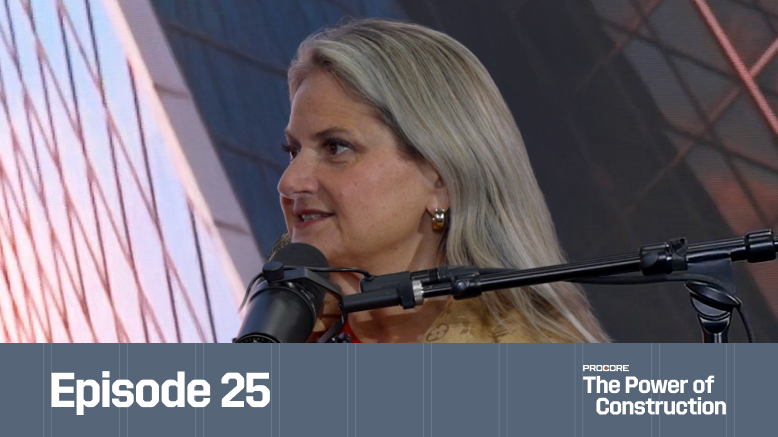— 7 min read
How to Choose the Best Construction Project Management Software

Last Updated Dec 10, 2025

Julia Tell
Contributing Writer
64 articles
Julia Tell is a freelance writer covering education, construction, healthcare, and digital transformation. She holds a Ph.D. in Media & Communications and has written for publications including Business Insider, GoodRx, and EdSurge, as well as nonprofits, international businesses, and educational institutions.
Last Updated Dec 10, 2025

Effective project management lays the foundation for the success of any construction project. While there’s no shortage of project management software solutions on the market, choosing one custom-tailored for construction projects can make it easier for contractors to complete projects.
As the construction industry faces challenges with labor shortages, supply chain issues and managing multiple risks, implementing digital tools can help companies make data-driven decisions to deliver quality projects that meet or exceed owner expectations.
This guide will help project managers and contractors choose the best construction project management software for their needs.
Table of contents
What Construction Project Management Software Is — and Why It Matters
Construction project management software is a digital tool used to plan, coordinate and execute construction projects.
Software platforms allow contractors and other stakeholders to monitor progress and efficiently allocate resources, connect to design and finance systems and manage documentation.
With centralized, real-time data in a digital management platform, teams can make adjustments collaboratively to streamline processes, reduce delays and improve productivity and project quality.
Key Features of Construction Project Management Software
By automating and optimizing important project management tasks, construction software helps teams avoid overlooking critical details and deadlines that can derail a project. Decision-makers should consider the following features when they're evaluating different options to integrate into their construction tech stack.
Scheduling
Effective scheduling keeps projects moving, preventing expensive delays and allowing for a smooth transition from one phase to the next. Modern construction management applications often include Gantt charts and work breakdown structures (WBSs) that display a visual timeline of tasks and track dependencies. This can include options for tasks that begin at the same time or sequentially, where one must end before another begins.
Budget Tracking
Budgets on large commercial projects are constantly in flux due to issues such as change orders, market fluctuations or weather delays. Budget tracking functionality in the form of a live budget dashboard shows committed costs, actual expenses and projected final costs in real time. Software that integrates smoothly with the company's financial applications helps PMs collaborate with business operations.
Financial Insights to Control Costs
Staying on budget and making data-informed decisions on changes is central to company success in construction. Keen Project Solutions, a full-service engineering, procurement and construction management (EPCM) company based in Iowa, found that real-time analytics from construction software helped them tightly control costs and streamline decision-making with all involved stakeholders.
The ERP integration has been incredible in terms of keeping track of project financials for superintendents, project managers, project engineers, project coordinators — whoever it is on the team.

Adam Aljets
Senior Project Manager
Keen Project Solutions
Document Management
By the time a commercial or public construction project is completed, contractors can end up with thousands of documents. Construction project management software can make it simple to store, organize and access all of these documents, including drawings, blueprints, contracts, requests for proposals, change orders and more.
For any issues or disputes that may arise, organized and accessible documentation helps determine responsibility and liability for quicker resolution.
Team Collaboration
When coordinating with multiple stakeholders — such as superintendents, subcontractors, architects, engineers and clients — project managers need to communicate clearly and efficiently to keep everyone on the same page. Construction project management software can facilitate collaboration by providing a centralized source of truth with threaded conversations, notifications, alerts, task assignment and project tracking and daily communication logs.
Licensing Model
For most large, commercial construction companies, an unlimited user access model could be a better licensing option than a seat-based option or naming specific licensees. This gives teams the flexibility to change users as needed and support frictionless collaboration.
Mobility
Contractors need to access software wherever they are — at the office, in the field or during off-site meetings. Native mobile applications include real-time updates and offline-capable access so teams can access documentation and workflows even without internet access.
Reporting and Analytics
The reporting and analytical capabilities of software give project managers insights that foster proactive instead of reactive decision-making. They can use this data to implement a continuous improvement feedback loop to make future projects more efficient and profitable.
Analytics dashboards aggregate performance data across project management, quality, safety and financials. Predictive analytical models let contractors identify risks and performance trends early so they can mitigate them.
Security
With cyberattacks on the rise in every industry, security is a primary concern, both for intellectual property protection and regulatory compliance. Teams should look for software that provides security measures such as strong data encryption, infrastructure redundancy and compliance with security frameworks like the National Institute of Standards and Technology (NIST) Cybersecurity Framework and the International Organization for Standardization (ISO) 27001.
Secure solutions should also provide role-based access and authentication. Measures such as single sign-on (SSO), OAuth 2.0 standards and secure password management will protect data from unauthorized access.
BIM and Reality Capture Integrations
Integrating Building Information Modeling (BIM) and reality capture technologies into construction project management software enhances precision and efficiency in project execution. BIM’s comprehensive digital representation of a building's characteristics helps teams identify potential design clashes and optimizes construction sequences, improving collaboration among architects, engineers and contractors.
Reality capture technologies, such as drones and laser scanners, provide accurate, up-to-date site conditions to compare the current state of a construction site with the BIM model, identifying discrepancies early. Software that can integrate these features reduces costly errors and helps companies move forward with the most advanced technology solutions available.
Free AI in Construction Course with Hugh Seaton
Start learning today with industry expert Hugh Seaton and discover how AI can boost efficiency, reduce risk, and transform your projects.

How To Evaluate Project Management Software for Construction
When evaluating construction software options, decision-makers should look at the following features and compare them among different vendors.
Ease of Use
Even the best software will be useless if it’s too clunky and difficult to navigate. An intuitive user experience reduces onboarding friction and makes it simple for people to incorporate into existing workflows.
Implementation and Adoption Support
Most construction project management solutions are feature-heavy, so ask about training resources, webinars and ongoing updates. While it should be easy to use, project managers will also want to be able to deep-dive into specific features to get the most out of the program.
Scalability
As a company grows, project management software will need to grow as well. Contractors may want to bypass a vendor if they're already at the upper end of its capabilities.
Product Development Culture
Talk to the vendor about how often they update the product. Ideally, work with a company that is continuously improving its product. This includes adding and updating features to enhance their functionality for project managers.
Customer Support
When contractors are in the middle of a project and have an issue with the software, they need answers quickly. Decision-makers should ask what they can expect in terms of response times and the level of accessibility of customer support.
References and Case Studies
The best way to evaluate a vendor is to ask its customers about their experiences. Project managers can prioritize feedback and outcomes from firms that are similar to theirs, both in size and types of projects.
Partnership Mentality
The best option will be a company that considers itself a business partner. Teams should assess factors such as long-term value, cultural alignment and proactive engagement.
Choosing the Right Construction Software for Your Team’s Needs
Project management construction software selection is central to optimizing operations and improving productivity while maintaining quality. Before choosing construction project management software, it's a good idea to sit down with the personnel who are involved in managing projects. They can brainstorm the features that matter most for their workflows and that will make the most impact on the business.
Building a connected construction tech ecosystem will help construction companies operate more efficiently across all aspects of their operations. Making the right choice depends on factors such as company size and the complexity of its projects.
As each increases, leaders need software that can accommodate them. Adopting a comprehensive software solution can help companies retain talented employees who appreciate the support of advanced workplace tools, deliver quality projects and impress owners with transparent communication.
Was this article helpful?
Thank you for your submission.
0%
0%
You voted that this article was . Was this a mistake? If so, change your vote
Scroll less, learn more about construction.
Subscribe to The Blueprint, Procore’s construction newsletter, to get content from industry experts delivered straight to your inbox.
By clicking this button, you agree to our Privacy Notice and Terms of Service.
Thank you!
You’re signed up to receive The Blueprint newsletter from Procore. You can unsubscribe at any time.
Categories:
Written by

Julia Tell
Contributing Writer | Procore Technologies
64 articles
Julia Tell is a freelance writer covering education, construction, healthcare, and digital transformation. She holds a Ph.D. in Media & Communications and has written for publications including Business Insider, GoodRx, and EdSurge, as well as nonprofits, international businesses, and educational institutions.
View profileExplore more helpful resources

Profit from Predictability: Construction Software as a Business Strategy
For general contractors, managing complex, multi-million-dollar projects, every project phase — from planning and budgeting to on-site execution — is an opportunity to lose time and money. Construction software is...

Defending Against Financial & Legal Risks on Megaprojects
The construction industry has seen marked growth in megaprojects. Some experts classify any project over $500 million as a megaproject, while others argue that the build needs to be $1...

Unlocking Project Intelligence: Moving from Raw Data to Actionable Insights
The construction industry faces a wide range of challenges, from ongoing labor shortages to frequent cost overruns. But some the biggest hurdles all stem from unpredictability. The general contractors (GCs)...

Who is accountable for innovation in construction?
Everyone says construction needs to innovate—but no one agrees on who’s actually responsible for making it happen. Is it the owner? The builders? The tech vendor? Or is innovation everyone’s...
Free Tools
Calculators
Use our calculators to estimate the cost of construction materials for your next project.
Templates
Find a template to help you with your construction project tasks.
Material Price Tracker
Get the latest U.S. retail prices and view historical trends for common building materials.
Glossary
Explore key terms and phrases used in the industry.
